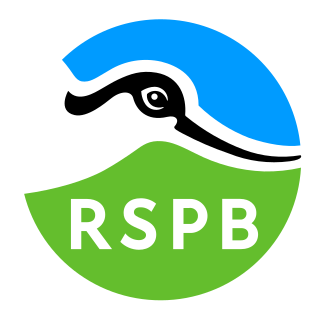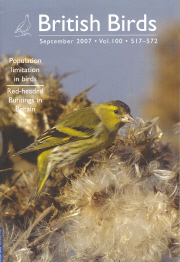
Devon Birds, known as the Devon Bird Watching & Preservation Society from its founding in 1928 until it was renamed in 2005, [1] is one of the UK's regional ornithological societies.

Devon Birds, known as the Devon Bird Watching & Preservation Society from its founding in 1928 until it was renamed in 2005, [1] is one of the UK's regional ornithological societies.
The society was formed for birdwatchers and ornithologists in Devon, England, in 1928, making it one of the oldest ornithological societies in the country. It organises lectures, field trips and research, and publishes newsletters bimonthly and reports three times a year. It is a registered charity, number 228966. [2] The society's logo is a Montagu's harrier. The differences between the hen harrier and the Montagu's were first described by George Montagu, a naturalist based in Kingsbridge.
It is responsible for, or is involved in, a number of reserves. These include South Milton Ley; [3] a site at Prawle Point; [4] a hide at Fernworthy Reservoir on Dartmoor; a site at Bradiford; and a ringing hut at Slapton Ley, data from which has been passed to the British Trust for Ornithology since 1960 for inclusion in national and international records and studies. [5]
The society is a member of the Devon Biodiversity Steering Group [6] and provides data to various environmental plans initiated by Devon County Council—for instance, in 2005 it contributed data to the Devon Biodiversity Action Plan. [7] In 1993 and 2003 the society was a major partner in the barn owl surveys undertaken in Devon by the Barn Owl Trust, [8] [9] and in 2009 it is helping fund a project to boost the birds' numbers in West Devon. [10]
In 2002 it was reported in the national press that Gordon Vaughan, a chairman of the society, and one of Devon's most respected ornithologists, [11] had discovered that dormice, newly emerged from hibernation, were eating the eggs of pied flycatchers, a rare bird in Devon. [12]
Past and present

Lundy is an English island in the Bristol Channel. It forms part of the district of Torridge in the county of Devon.

The Royal Society for the Protection of Birds (RSPB) is a charitable organisation registered in England and Wales and in Scotland. It was founded in 1889. It works to promote conservation and protection of birds and the wider environment through public awareness campaigns, petitions and through the operation of nature reserves throughout the United Kingdom.

Birdwatching, or birding, is the observing of birds, either as a recreational activity or as a form of citizen science. A birdwatcher may observe by using their naked eye, by using a visual enhancement device such as binoculars or a telescope, by listening for bird sounds, watching public webcams, or by viewing smart bird feeder cameras.

British Birds is a monthly ornithology magazine that was established in 1907. It is now published by BB 2000 Ltd, which is wholly owned by The British Birds Charitable Trust, established for the benefit of British ornithology. Its circulation in 2000 was 5,250 copies; its circulation peaked at 11,000 in the late 1980s. The current editor is Stephen Menzie.

The British Trust for Ornithology (BTO) is an organisation founded in 1932 for the study of birds in the British Isles. The Prince of Wales has been patron since October 2020.

George Montagu was an English army officer and naturalist. He was known for his pioneering Ornithological Dictionary of 1802, which for the first time accurately defined the status of Britain's birds. He is remembered today for species such as the Montagu's harrier, named after him.
BirdWatch Ireland (BWI) is a voluntary conservation organisation and registered charity devoted to the conservation and protection of wild birds and their habitats in Ireland. It was formerly known as the Irish Wildbird Conservancy (IWC). Irish Wildbird Conservancy was founded in 1968, among others by Major Robert (Robin) Ruttledge, an Irish ornithologist who became its first president.

Slapton is a village and civil parish in the South Hams district of Devon, England. It is located near the A379 road between Kingsbridge and Dartmouth, and lies within the South Devon Area of Outstanding Natural Beauty (AONB). The nearby beach is Slapton Sands; despite its name, it is not a sandy beach but a shingle one.

Slapton Ley is a lake on the south coast of Devon, England, separated from Start Bay by a shingle beach, known as Slapton Sands.

The South Devon National Landscape covers 337 square kilometres, including much of the South Hams area of Devon and the rugged coastline from Jennycliff Bay to Elberry Cove near Brixham. The purpose of an Area of Outstanding Natural Beauty is to conserve and enhance the area's natural beauty. In South Devon this includes: undeveloped coastline, estuaries, geological and geomorphological features, expansive panoramic views, ancient agricultural field pattern, Devon banks, areas of high tranquility, dark night skies and natural nightscapes, historic features, green lanes, well known cultural associations, picturesque villages and hamlets. South Devon AONB was formally designated in August 1960 under the National Parks and Access to the Countryside Act 1949. The highest point in the AONB is Blackdown Camp at 199 metres above sea level.

David Tipling is a professional wildlife photographer. He has won the documentary award for the European Nature Photographer of the Year for his work on emperor penguins.

Wild Planet Trust, formerly known as the Whitley Wildlife Conservation Trust (WWCT), is a registered charity, set up to run Paignton Zoo after the death of its founder, Herbert Whitley, who established the zoo on his estate at Primley, Paignton in Devon in the 1920s.
Paul George William Salaman is an ornithologist and conservationist based the Rainforest Trust, overseeing biodiversity conservation across Latin America.

The Gower Ornithological Society is a society for professional and amateur birdwatchers covering the geographical areas of south Wales comprising Gower, Swansea, Neath and Port Talbot.
The Welsh Ornithological Society is an organisation which promotes the study and conservation of birds in Wales. Each year it organises a conference and publishes two issues of the journal Welsh Birds, one of which contains the Welsh Bird Report. It was founded on 26 March 1988 at a conference in Aberystwyth. It now has about 250 members. The television presenter and author Iolo Williams has been the society's president since November 2009.
The Sussex Ornithological Society (SOS) is a British registered charity dedicated to the study, recording, and conservation of wild birds and their habitats in the English historic county of Sussex. It was founded in 1962 and is one of the largest county bird clubs in Great Britain with a membership of 1988 as at the end of financial year in December 2014.

The Ornithological Dictionary; or Alphabetical Synopsis of British Birds was written by the English naturalist and army officer George Montagu, and first published by J. White of Fleet Street, London in 1802.

Hawk Ridge is a nature reserve and bird observatory renowned for its autumnal raptor migrations. The Audubon Society describes Hawk Ridge as "one of the premier sites in North America". P. B. Hofslund, one of the first ornithologists to conduct research there, pronounced it "one of the great hawk flyways of the world". Twenty-thousand birdwatchers visit Hawk Ridge each year to view the migration. It is an important site for ornithological research.